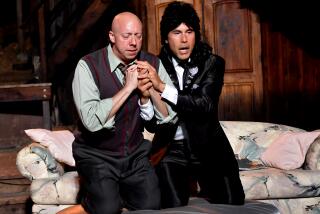Survival of the most alluring
Based on Michael Pollan’s book of the same name, “The Botany of Desire,” airing tonight on PBS, looks at the ways in which plants have advanced their agenda, metaphorically speaking, by making themselves attractive to humans. There is a lot of speaking in metaphors in the two-hour documentary, much of it by Pollan himself, who regularly takes pains to remind us that he is, in fact, speaking metaphorically, because we have no words to describe the psychology of species beside our own. Besides, a little anthropomorphizing can be a useful thing when you’re telling a story, especially when the moral is that we are all in this together, plants and people and every living thing, and so mutually dependent that it’s impossible to tell the user from the used.
All plants share an “existential predicament,” Pollan says, in that they cannot move. And yet they have gotten themselves around the world, sometimes stowing away, but sometimes showing a bit of metaphorical leg, like Claudette Colbert in “It Happened One Night,” to flag down a ride. It was Pollan’s inspiration to try to view this process from the point of view of the plant. The four species profiled here are the apple tree, which does its work by sweetness; the tulip, which seduces with its beauty; cannabis, which gets you high, dude; and the potato, which, if I understand it correctly, gives you the illusion of “control” by being easy to grow with a high yield and full of calories and nutrients.
This is, as you might imagine, an extremely pretty show -- not the potatoes or the pot so much, though some of the marijuana plants, reshaped by hydroponic farming and a kind of “extreme sexual frustration” (that’s correct) to get you even higher -- dude -- look like Dale Chihuly glass sculptures. And the Peruvian potatoes come in a surprising variety of shapes and colors, each adapted to its own mountain microclimate. (Compare and contrast with the Burbank Russet, the McDonald’s French fry potato, which has taken over Idaho.) The tulips are, of course, beautiful, and the apples look good enough to eat, even the ones that aren’t.
Besides being nice to look at it, it is full of interesting things to know. We visit the wild apple forests of Kazakhstan, get the lowdown on Johnny Appleseed, the cider boom, and the rebranding of the apple as a talisman against doctors. The marijuana section, which includes clips of films I’m sure I saw in health class (and footage of Louis Armstrong that I’m sure I didn’t) is the certainly rare instance in which a public television documentary, by virtue of its theme, paints pot as a success story. We go to Amsterdam’s pot-filled “coffee shops” and to labs where mice are made forgetful. (THC, the active ingredient in marijuana, mimics the naturally occurring brain chemical anandamide, which helps us forget -- something we never would have learned if some people didn’t smoke pot and other people didn’t study them.)
For the tulip, we travel to Holland in the 17th century, when a prized bulb could cost as much as a house, and where today the international flower market is largely based, a multibillion-dollar trade in what Pollan calls “exquisitely useless” things. The humbler potato takes us to the Andes, and to Idaho, and to Ireland, where the spud first fed a nation and then, when a spore killed them all, didn’t.
That was not the fault of the potato, but of a decision to plant only one variety of spud all over Ireland, so that when disaster came, it came everywhere. Though Pollan sees human interference in plant life as part of the evolutionary process, its effects can be disastrous. (Except in marijuana, apparently, where we’ve done great things.) Monoculture, in which naturally occurring varieties of a plant are suppressed in favor of the ones that sell, is the enemy of genetic health, requiring the farmer to pour on the pesticides. Pollan’s pitch is for diversity; all four segments are essentially a pitch for working with, rather than against, nature.
He remarks at one point how strange it is that humans and bees should react positively to so many of the same things -- the same sorts of colors, patterns, perfumes. And whether it is the case that the bee is more human than you might have imagined or the human more of a bee than you would like to imagine, Pollan’s larger point is that we are all in it together. While that is not exactly news, it remains the great still-needs-to-be-really-learned lesson of our time, if we want a future with buds and bees in it.
--
--
‘The Botany of Desire’
Where: KCET
When: 8 tonight
Rating: TV-PG (may be unsuitable for young children)
More to Read
The complete guide to home viewing
Get Screen Gab for everything about the TV shows and streaming movies everyone’s talking about.
You may occasionally receive promotional content from the Los Angeles Times.







